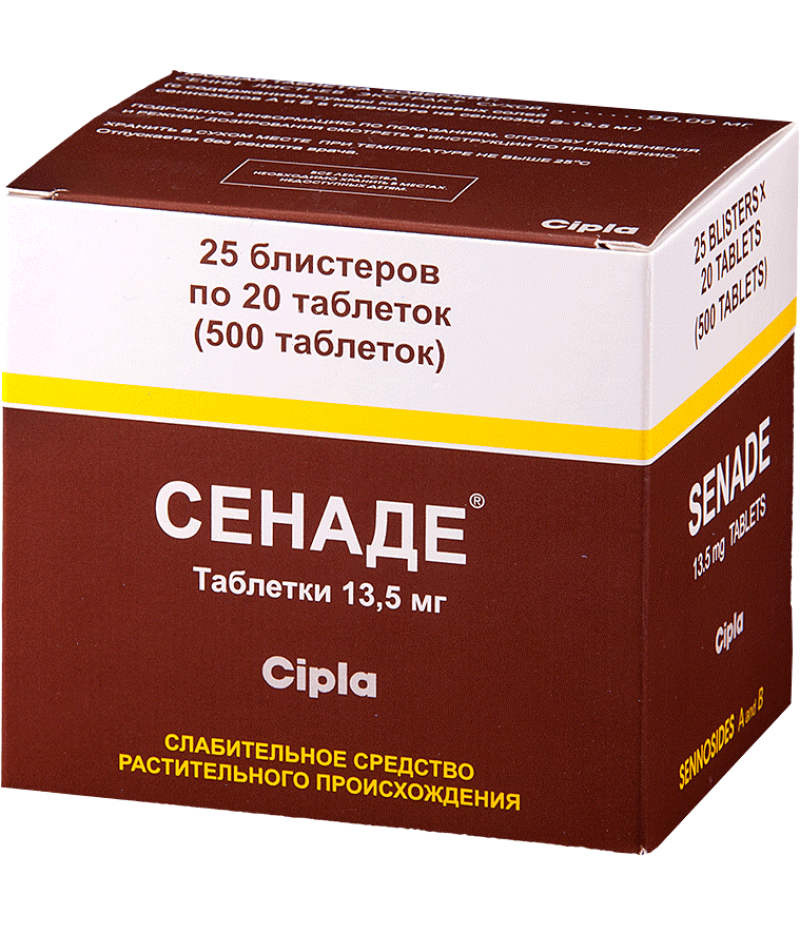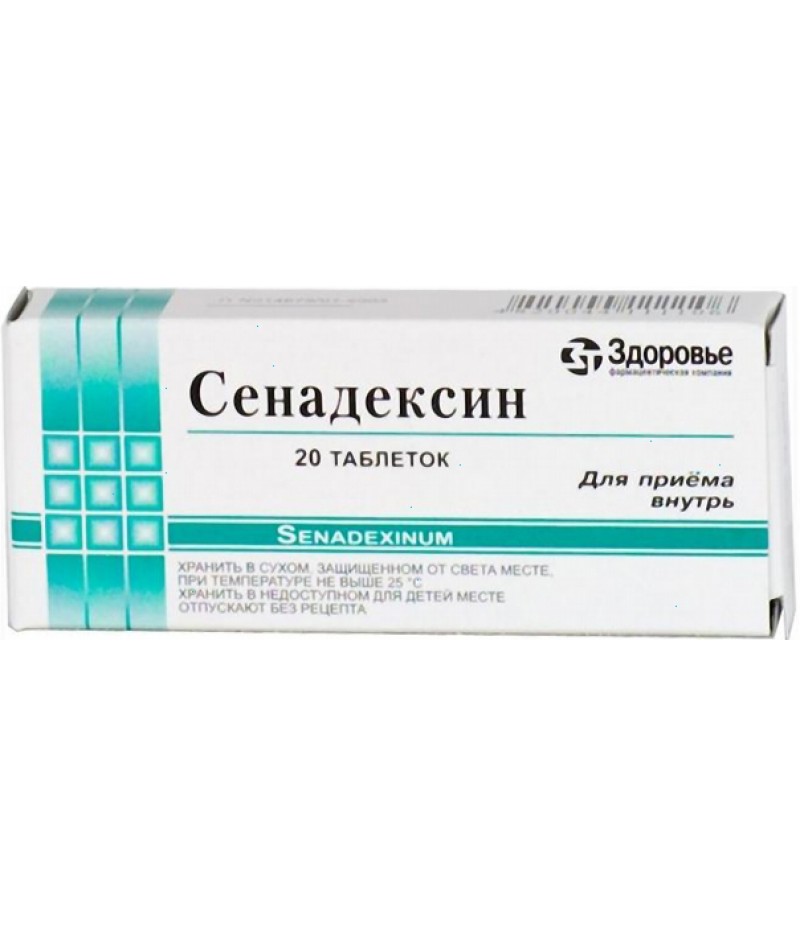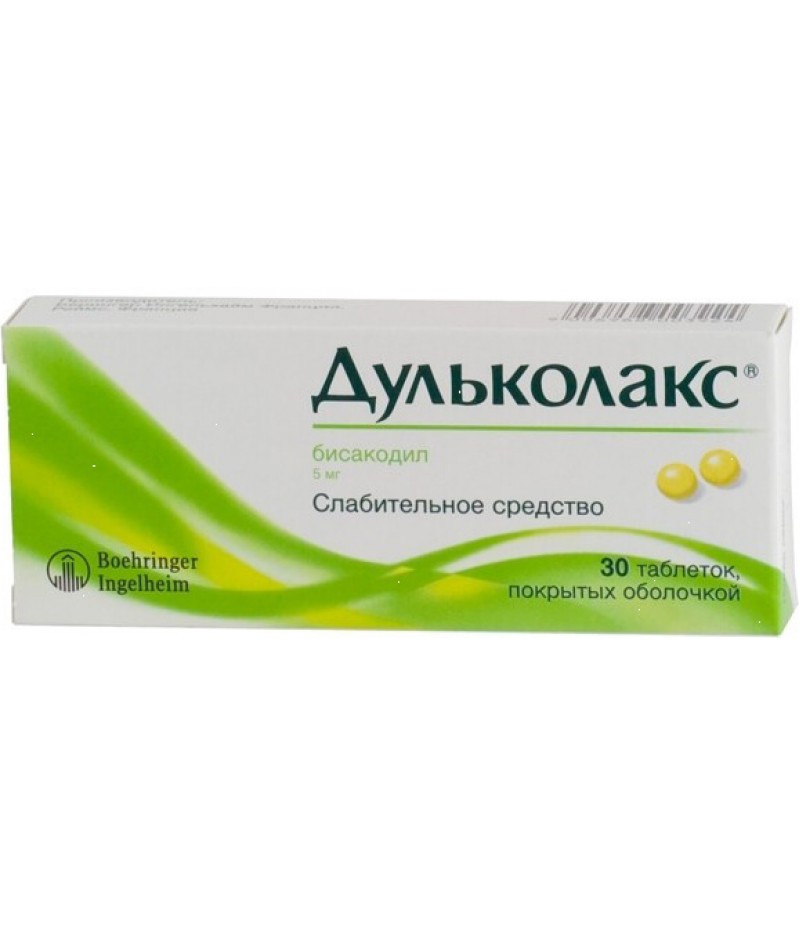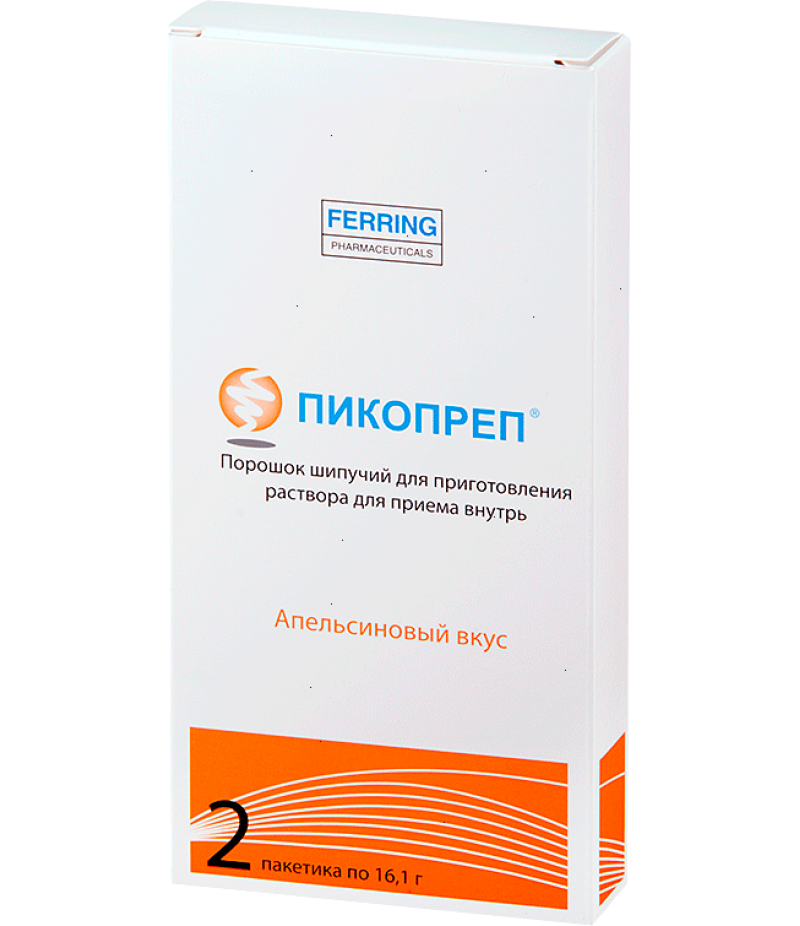Senade 13.5mg #500
- $35.57
- 3 or more $33.90
- Availability:In Stock
Senade instructionReed more about Senade and buy it on this pageThe drug Senade refers to the pharmacological group of laxatives. It accelerates intestinal peristalsis, increases the volume of water in its lumen and promotes softe..
Senade instruction
Reed more about Senade and buy it on this page
The drug Senade refers to the pharmacological group of laxatives. It accelerates intestinal peristalsis, increases the volume of water in its lumen and promotes softening of stool. It is used to treat intestinal pathology accompanied by chronic constipation.
Composition and form of release
The preparation Senade is available in the form of a tablet for oral (oral) use. They have a dark brown color, a flat-cylindrical round shape. The main active component of the drug is the extract of Senna leaves, its content in the 1st tablet is 93.3 mg. Also the composition of the preparation includes auxiliary components, which include:
Methylparahydroxybenzoate.
Magnesium stearate.
Starch.
Microcrystalline cellulose.
Lactose.
Carmellose sodium.
Talc.
Sodium lauryl sulfate.
Tablets Senad packaged in a blister for 20 pieces. Cardboard pack contains 2, 3 or 25 blisters with tablets, as well as instructions for using the drug.
Pharmacodynamics and pharmacokinetics
The extract of senna leaves, which is the main active component of Senade tablets, contains a number of plant glycosides. After taking the drug inside, they are unchanged through the stomach and small intestine. In the large intestine, under the action of bacterial flora enzymes, these glycosides are cleaved to form active components (anthranol and antron), which promote the accumulation of mineral salts and water in the lumen of the gut with softening of fecal masses. Due to this, the therapeutic laxative effect of the drug is realized within 6-10 hours after taking the tablet.
Indications for use
The main indication for the reception of Senada tablets is the development of chronic constipation, in particular, associated with a decrease in intestinal tone (hypotension) or its absence (atony). Also, the drug is used to soften the stool with a certain pathology of the lower parts of the digestive tract, including hemorrhoids, cracks or inflammation of the rectum. Before conducting diagnostic studies of the lower intestine, the drug can be used as a preparation preparation, including colon cleansing.
Contraindications
There are a number of pathological and physiological conditions of the human body, in which the reception of tablets Senade is contraindicated, they include:
Intestinal obstruction.
Spastic constipation, provoked by excessive increase in the tone of the intestinal wall.
Bleeding from the stomach or intestines.
Uterine bleeding in women (metrorrhagia).
Strangulated hernia, characterized by infringement of the intestinal loop in the hernial sac.
Acute inflammatory bowel pathology or pathological process in peritoneum (peritonitis).
Pain syndrome with localization in the abdominal region, which has an unknown origin.
Ulcerous lesions with violation of the integrity of the walls of the stomach or intestines (ulcers, erosion).
Inflammation of the urinary bladder (cystitis).
Individual intolerance to any of the components of the drug.
The patient's age is less than 6 years.
Caution Senade tablets can be used for various liver or kidney pathologies, during the recovery period after surgery on the abdominal organs, as well as during pregnancy and breastfeeding (lactation period). Before starting the use of the drug, it is important to make sure there are no contraindications.
Dosing and Administration
Tablets of Senada are intended for oral (oral) reception. They are usually taken 1 time a day in the evening before going to bed, do not chew and drink with enough water. The recommended therapeutic dose for adults and children over 12 years is 1 tablet 1 time per day. If necessary, to achieve a sufficient therapeutic effect, the dosage can be increased to 2-3 tablets. For children aged 6 to 12 years, the recommended dosage is ½ tablets, it can be increased to 1-2 tablets. The recommended mode of application of the drug includes a gradual increase in dosage to achieve a therapeutic effect. If there is no loosening of the stool on the 3rd day after the start of the Senade tablets, you should consult a medical specialist.
Side effects
Against the background of taking Senad tablets, it is possible to develop negative pathological reactions from various organs and systems:
Digestive system - pain in the abdomen, which have the nature of colic, bloating (flatulence), nausea, recurrent vomiting, laying melanin on the mucosa of the intestinal walls with prolonged use of the drug in high dosages.
Cardiovascular system - decrease in the level of systemic arterial pressure up to the vascular collapse, which is associated with dehydration (dehydration).
Nervous system - increased fatigue, confusion, convulsions, associated with a decrease in the concentration of mineral salts in the body.
Metabolism - a violation of water-electrolyte balance, associated with a decrease in the water content and mineral salts in the body.
Skin and its appendages - the appearance of skin rashes on the background of long-term use of the drug.
The appearance of signs of side effects against the background of taking Senade tablets is the basis for the withdrawal of the drug and visits to the doctor.
special instructions
Before you start taking Senade tablets, you should carefully read the instructions and pay attention to a few indications of the use of the drug, which include:
The maximum duration of the drug should not exceed 14 days, which is associated with a high risk of subsequent development of dehydration of the body.
The possibility of using the drug for pregnant women is determined only by a doctor under strict medical indications, since they significantly increase the risk of developing negative pathological reactions.
Against the background of taking the drug, urine can acquire a yellow-brown or red-lilac stain, which is not a pathological reaction and a reason to cancel the drug.
Against the background of long-term use of Senada tablets, it is possible to intensify the action of group cardiac glycosides, which is associated with a decrease in the concentration of potassium ions.
Thiazide diuretics (diuretics) significantly increase the risk of dehydration and loss of mineral salts against the background of the drug.
In connection with the possible decrease in the concentration of mineral salts on the background of the use of the drug, it is possible to suppress the functional activity of the cerebral cortex with a decrease in the rate of psychomotor reactions and the ability to concentrate.
In the pharmacy network, Senade tablets are dispensed without a prescription. If you have any doubts about the use of the drug or negative reactions after taking pills, you should consult a medical professional.
Overdose
With a significant excess of the recommended therapeutic dose of Senade tablets, there is a pronounced diarrhea leading to dehydration of the body. In this case, pathogenetic therapy is used in the conditions of a medical hospital, aimed at restoring the water-electrolyte balance of the organism.
Analogues of Senade tablets
Similar in composition and therapeutic effect for Senade tablets is Senadixine.
Terms and conditions of storage
The shelf life of Senade tablets is 3 years. They must be stored in the original factory packaging, dark, dry, inaccessible to children at an air temperature of not more than 30 ° C.




